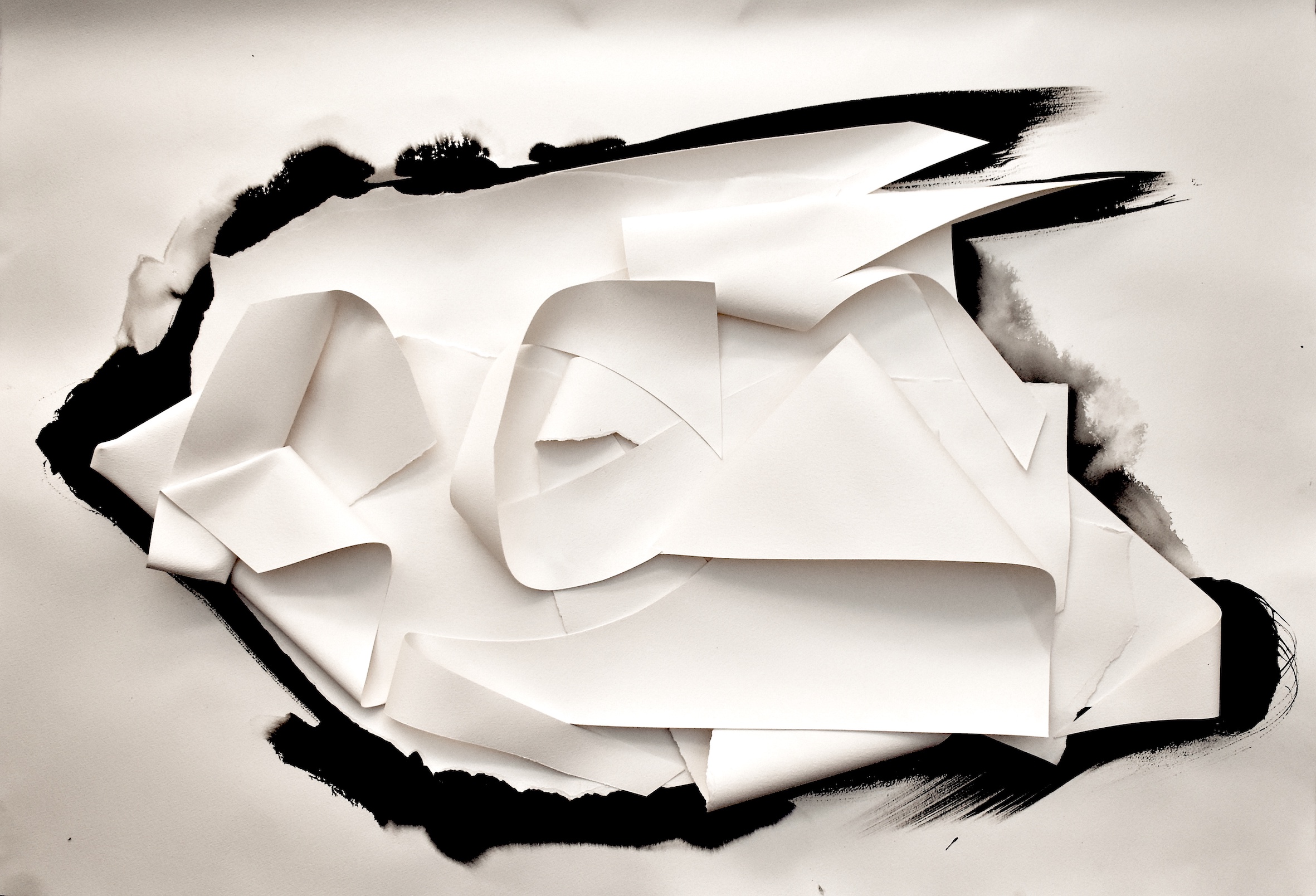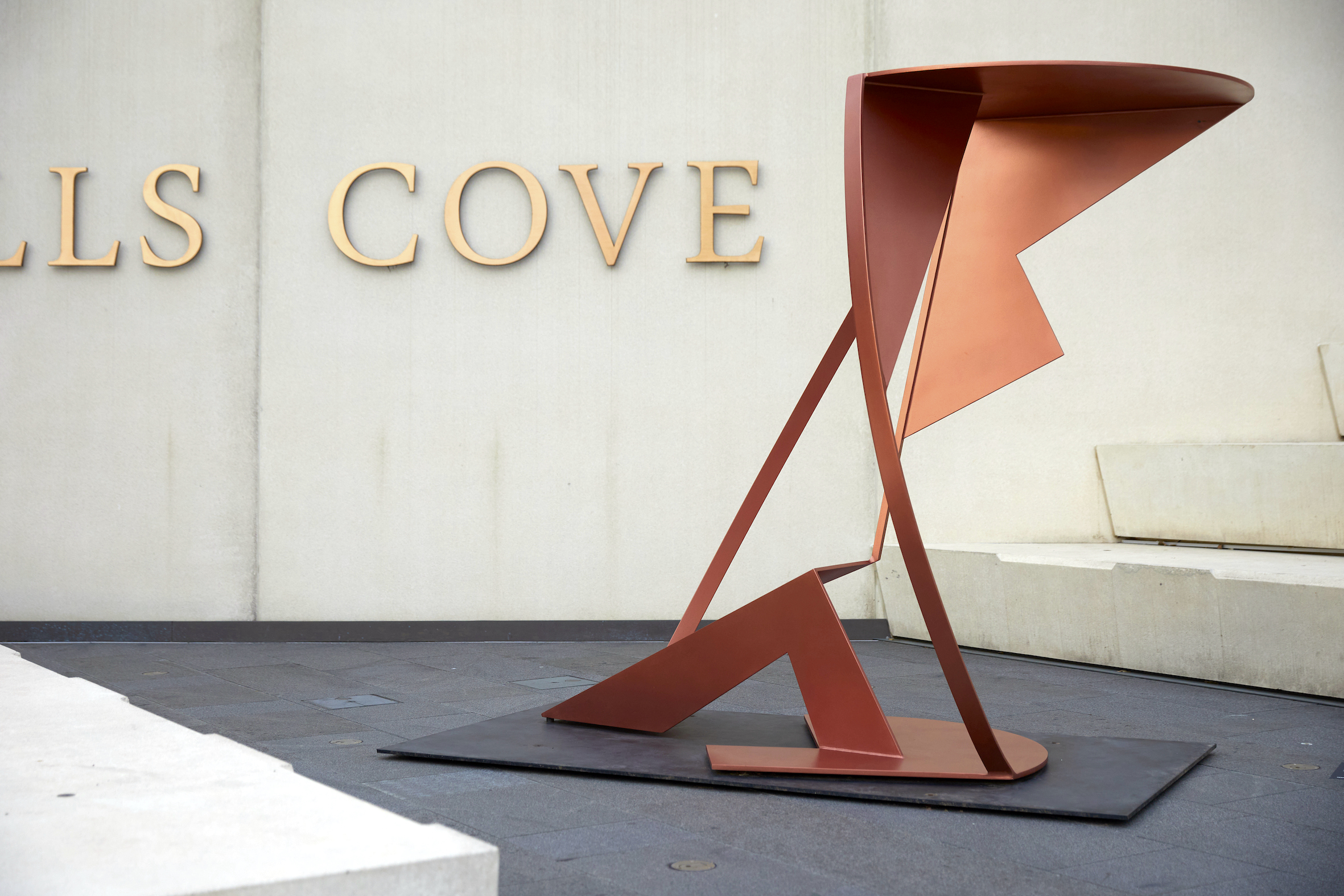Ayako Saito: Folding Space
Ayako Saito with her sculpture 'Heaven's Door' (2018). Painted steel, 80 x 200 x 400 cm. (Photograph: Michael Zanetti)
I came to know Ayako at the National Art School in Sydney, where she was welding in the workshop and I was studying at the time. She has an impressive reputation for her large, outdoor steel sculptures and public commissions around Sydney. Brightly monochromatic, geometric, and multi-faceted, these works feature planes and curves that have bisected many iconic views of the city’s coastal landscape and buildings.
On the October afternoon I meet with her online, she is wearing red and is on the move, making tea and carrying her phone as she sits down to talk. Quite often, she steers the interview, which is supposed to be about her, to ask her own questions about me. She uses her hands a lot while talking – they flutter, gesture, and slice through the air. I think of how they resemble the precise and dynamic forms of her sculptures.
LP: What was your journey to becoming an artist? And, as it seems related, what was your journey from Japan to Australia?
AS: I was born in Tokyo and I spent my childhood in Yokohama, a lot of it in nature. I moved back to Tokyo when I was 10. After attending university, I left Japan in 2002 to further my studies in Australia and started studying sculpture at ANU (i). In first and second year, we did the basic things: learning about lots of different materials, sculptural conventions, installations, etc. From third year we could do more specific things according to our individual interests, and I was doing modeling in plaster – making organic, figurative, and abstract forms and casting them in bronze. After that I felt like I hadn't done enough work, so I did Honours and then I ended up doing Masters, just so that I could continue to work. I haven't stopped since.
(i) ANU is the Australian National University in Canberra.
LP: You are known for your large-scaled steel sculptures, although you also make work at smaller and more intimate scales. Could you tell me about your practice and how that evolved?
AS: It was an interesting shift for me, as I initially did modeling at a smaller scale. Towards the end of my Masters course, I thought I would make a base for my works, for presentation. I started making the base in steel, but the base ended up as the sculpture. Then with that work as a maquette, I applied for Sculpture by the Sea (ii) for the first time. That work, Pavilion, became my first large-scale sculpture. Construction is a different sensibility to modeling. It is more structural and architectural. Again (and it’s the same with all practice), you just start playing and manipulating materials, learning how to do more, how to make different shapes. Until that point when the parts come together and make a whole and have a particular character.
(ii) Sculpture by the Sea is a major public sculpture event in Sydney, usually taking place for a few weeks in January and utilizing the natural plinths of a rocky cliffside walk between Bondi and Tamarama Beaches.

LP: What are you working on at the moment?
AS: Basically, I just keep making, and there are lots of works in progress in my studio. Covid lockdown has given me more time to concentrate on my work. We can’t do anything else, so working time and thinking time is more intense.
During lockdown I started playing with paper, which I always liked, but didn’t have the time to concentrate on the process. Now I’ve been making paper collages. I tear, cut, wet it, and make a shape. It’s not dissimilar to the steel work I do, but the paper is flat, softer, and flexible. I can twist it in a way I can’t with steel. I guess playing with paper gave me a different feel to my steel-working process. With the extra freedom, I discovered using paper and found objects in steel. I think they have all come together to further enrich my sculpture.
LP: How do you see the role of an artist in society? Do you feel there are differences in the way art and artists operate and are received within the cultures of Japan and Australia?
AS: On the role of artist, I think that art is a fundamental human endeavour. I think the role of art is just being art. It’s a bit like we all have to eat, and we all have to sleep, and we all have to work and so on and so forth, and society changes all the time, but having art is part of it. It is a very healthy thing.
I’ve mostly lived in Australia since I started being an artist and haven’t worked or exhibited in Japan. So, I personally don’t know how artists are received in Japan.
The fact that I like making things with my hands is maybe some sort of Japanese cultural thing. I really liked origami as a kid, I always played with origami. Now I hear people say that my sculpture looks like origami, and I never intended that, but it may have come through. I’m not self-consciously trying to be Japanese in my art.

LP: I recently saw the exhibition Another Energy at Mori Art Museum, which presented 16 women artists from around the world, aged between 71 and 105. Do you think you’ve had a different journey, being an artist who is a woman?
AS: I heard some of the interviews [from the exhibition]. It was so nice because they are mature artists, and they were very honest and direct. I found that really refreshing. One of the artists [Kimiyo Mishima] gave good advice to younger artists: not to lose their sense of curiosity. I really agree with that. Instead of guessing what will happen, we never know until we do it, and not getting trapped into a “style.”
LP: Given that travel has been so restricted in recent times, what do you miss the most about Japan – what would you do if you were here now?
AS: I miss the hot springs. I would like to learn how to do kintsugi, and just recently I became interested in lacquerware. I admire the sensibility they have for the materials.
Do you know Masako Shirasu? She is a writer and introduced a lot of Japanese artisans through her writing. She interviewed artisans who lived in the middle of nowhere, who really, just wanted to be left quietly to do their work. I find that quite refreshing, these days we are forced to promote ourselves.
LP: I know that feeling too, and thank you for doing this interview, which I hope is beyond promotion and gives an insight into your practice. What encourages you to keep making art?
AS: Making sculptures is at the core of my life.

Ayako is clearly a disciplined and accomplished artist, but is also delightfully prosaic about her practice. Her site-referenced abstract sculptures seem to be out of this world; Their hard, monochromatic forms test the purity of form, colour, and the limits of rigid materiality with musical expressiveness. And yet, these works are also of this world, formed from its elemental metals. They split, splice, and even create space within natural and urban landscapes. This applies equally to her smaller scaled and more intimate works, and to the recent works using paper and ink to fold space. Ayako is guided by an abiding curiosity about her materials and an ethos of just doing in her practice. Amid a shrinking divide between artist and artisan, where values of consistency and craft continue quite apart from issues of ego and promotion, the words of Masako Shirasu remind us:
“The appreciation of art is not a process of folding one’s arms, viewing and listening to the explanations of others, but rather of participating in the acts of the people who create it.”
To learn more about Ayako Saito and her work:
Website: ayakosaito.com
Instagram: www.instagram.com/ayako_saito_art
Lisa Pang
Lisa Pang



